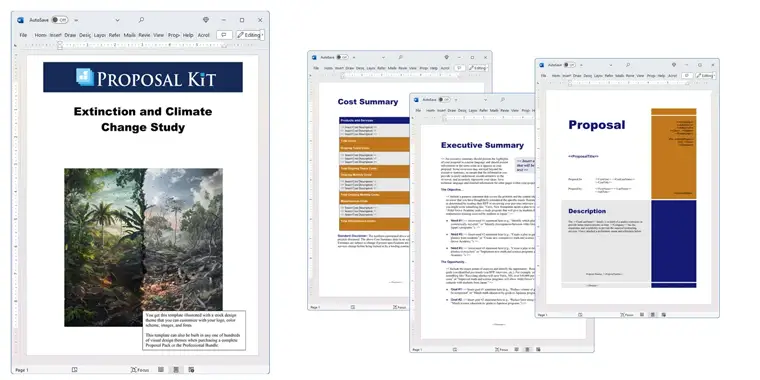How to write your Extinction and Climate Change Study
We include this 26 page layout with every Proposal Pack. If you want this template to have a different visual design theme than the one illustrated here, purchase any Proposal Pack design and create this template using the purchased design theme. This template is included in every Proposal Pack. If you get a Proposal Pack or the Professional Bundle, you can also make any variation of this template with different chapters to suit your needs.
We typically include more chapters in the templates than most people will need to give everyone more variety in the chapters they may need. You can trim down a long template by removing pages you do not need or combining multiple chapter topics into one page.
 DOWNLOADABLE, ONE-TIME COST, NO SUBSCRIPTION FEES
DOWNLOADABLE, ONE-TIME COST, NO SUBSCRIPTION FEES If you need this template on DVD media order from our Amazon shop.
If you need this template on DVD media order from our Amazon shop.
You can also create countless variations of this document to suit your needs using the included library of 2200+ chapters if ordering a Proposal Pack or Pro Bundle.
 What Our Clients Say
What Our Clients SayI love how the wizard streamlines the entire proposal creation process. I am a full time freelancer and this takes hours out of my administrative tasks each week. For the price, you really can’t beat it. I’ve been using Proposal Pack for 2 years now and each update to their system keeps getting better! I can include contracts as part of my proposals and have it all put together by the wizard. This is a huge time-saver for me and I wanted to be sure to add this for people who might be considering getting both -- great job by the company on this one!"
Expressive Elegance
Related Article
Related Video
Related Templates
- Climate Change Research Proposal
- Population Migration Due to Climate Change Study
- Climate Change Natural Resources Replenishment Problems Report
- Case Study Report
- Research Expedition Grant Funding Request
- Research Funding Request Proposal
- PhD Thesis Proposal
- Research Proposal (Short)
- International Research and Development Project Proposal
- Research Assistant Proposal
- Research Proposal (Long)
- Climate Change Causing Natural Resources Replenishment Problems Report
What's the Best Way to Write Your Extinction and Climate Change Study?
When writing a species extinction and climate change study, the best approach for those unfamiliar with creating such complex documents is to use the Proposal Kit template and software package. Proposal Kit simplifies the process by providing structured templates and tools, including a line item quoting database for managing financial elements like cost summaries, quotes, estimates, and budgets. This system not only aids in drafting a precise and organized study but also ensures that all financial aspects are clearly outlined and easily understood.
The Proposal Kit creates complex studies, plans, business documents, and proposals.
Are You Preparing to Write an Extinction and Climate Change Study?
If you are tasked with developing a study on how climate change affects species extinction, get started with a customizable pre-made template layout using Proposal Kit. You will need structured guidance and reliable tools to handle the depth and complexity of such a study effectively.
What Types of Projects Are Extinction and Climate Change Studies Written For?
Extinction and climate change studies cover a broad spectrum of research areas. These are important for understanding our environment's complex interactions and helping formulate strategies for biodiversity conservation. Some typical projects include:
- Assessing the impact of global warming on polar bear populations in the Arctic.
- Studying coral bleaching events in the Great Barrier Reef.
- Analyzing the effects of deforestation on Amazonian wildlife.
- Investigating the decline of bee populations and its impact on global agriculture.
- Researching the effects of rising sea levels on coastal ecosystems.
- Evaluating the impact of urban expansion on local bird species.
- Monitoring glacier retreat and its implications for freshwater supply.
- Examining the disruption of marine life due to ocean acidification.
- Documenting the migration patterns of species due to changing climatic conditions.
- Analyzing the resilience of various plants to extreme weather events.
Chapters this template is built with
There is no one-size-fits-all approach when undertaking a study as vital as extinction and climate change research. However, Proposal Kit offers a starting point with a wide array of customizable templates that can be tailored to fit the unique requirements of your study. Here are some of the templates you might use
These chapters are just a small selection from the thousands of templates available in Proposal Kit's extensive library, allowing you to customize your document to cover all necessary topics.
Cover Letter
The cover letter introduces your study to potential stakeholders or funding bodies. It should convey the urgency and relevance of your research, explain the possible impact of the findings, and express how their support can contribute to the study's success and broader environmental goals.
Introduction
Set the stage for your research by clearly outlining the study's background and its overarching objectives. This section should provide context on why the study is necessary and what it aims to achieve, setting up a logical flow into more detailed discussions of its components.
Abstract
The abstract offers a concise summary of the research and its findings. It should be tightly written to allow readers to grasp the essential aspects of the study quickly, including the research question, methodology, primary results, and conclusions.
Simulations
Describe any computer-generated models used in your study to predict future impacts. Detail the parameters used, the basis of these models, and how they help understand potential future situations under various conditions.
Environmental Effects
Discuss the broader environmental impacts observed or predicted as part of your study. This could include changes in habitat, shifts in local climates, or effects on biodiversity. Provide a context for how these changes affect ecosystems and human communities.
Methodology
Detail the methods used to gather data and conduct the research. This should include descriptions of experimental designs, survey techniques, observational methods, and analytical processes used to interpret the data.
Evidence
Present the data and evidence supporting your conclusions. This might involve quantitative data, qualitative observations, or synthesized results from various sources. Linking your proof to your conclusions enhances the credibility of your research.
Research
Summarize the scholarly research underpinning your study's premises. Discuss how your work builds upon or diverges from existing studies and what new insights it brings to environmental science.
Fieldwork
Outline the fieldwork conducted as part of your study, including locations, durations, and any significant incidents that impacted the study. Detail the findings from this fieldwork and how they contribute to the overall research.
Environmental Impact
Assess the environmental consequences of the observed changes. Evaluate the direct and indirect impacts on the environment, including any potential long-term effects that might not be immediately apparent.
Literature Review
Review existing literature to contextualize your study within the field. Highlight how your research addresses gaps in the current understanding and what it adds to the existing body of knowledge.
Extinction
Focus specifically on the species at risk and discuss the factors leading to their potential extinction. Analyze the roles of various pressures like habitat loss, climate change, pollution, and biological factors in these declines.
Decline
Analyze population declines, looking at trends and the driving forces behind these changes. Provide a detailed examination of the ecological, genetic, and environmental factors contributing to population declines.
Collapse
Discuss ecosystem or species collapse situations if relevant. Describe the conditions under which these collapses could occur and the potential recovery paths, if any.
Natural Resources
Evaluate how changing environmental conditions are affecting natural resources. Consider the impacts on water, soil, air, and biological resources, detailing any significant changes in availability or quality.
Species
In detail, specific species were affected, and the unique challenges faced by particular species were examined while considering climate change: detailed adaptive behaviors, resilience factors, and vulnerability aspects.
Climate Change
Examine the broader implications of climate change related to your study. Discuss global patterns, regional differences, and the anticipated effects on ecosystems and species.
Ecosystem
Explore ecosystem interdependencies and changes. Analyze how altered conditions affect relationships between species and their environments, including potential cascading effects throughout the ecosystem.
Conclusions
Conclude your research by linking it to the initial objectives and summarizing how your findings contribute to a broader understanding of climate change and species extinction.
Diagrams
Include diagrams that represent data and findings visually. These should be clear, well-labeled, and designed to complement the textual content, providing visual summaries of complex data.
Acknowledgments
Credit those who contributed to the study, including collaborators, advisors, and any organizations that provided funding or resources. This acknowledges their support and contributions.
Data
Present detailed datasets collected during the study. Describe how the data was collected, any adjustments made, and how it was analyzed. Ensure transparency and reproducibility of the research by detailing data handling methods.
Statistics
Use statistics to support your research findings robustly. Provide details on the statistical tests used, the justification for their use, and the significance of the results, helping to substantiate the study's conclusions.
Use cases for this template
Jasper's Research Initiative
Jasper, the owner of GreenFuture Innovations, recognized the need to understand how changing climate conditions could affect agricultural sustainability, particularly crop diversity, which is crucial for the resilience of food systems. His team embarked on a project to study the potential impacts of climate change on various crop species, which was important for developing his line of sustainable agricultural products.
Using the Proposal Kit, Jasper meticulously structured his research document. The study included detailed sections on anticipated climate variables, potential adaptive agronomic practices, and the expected shifts in crop viability zones. His well-organized document featured data projections, potential impact assessments, and adaptive strategies that comprehensively depicted the issues.
Li's Corporate Challenge
Li, an environmental analyst at EcoSolutions Corp, faced a challenge when her company was approached by a client needing a detailed climate impact study. The report was crucial for the client to finalize their new environmental policy adjustments. Li turned to Proposal Kit to organize her report structure and used AI tools to enhance her efficiency.
She used AI to pull relevant data and generate predictive models that could simulate various climate situations and their potential impacts on the client's operations. Li's report, enriched with AI-generated graphics and well-written narratives on possible future scenarios, was a comprehensive response to the brief.
Her ability to deliver a detailed, insightful climate impact study under tight deadlines met her client's immediate needs.
Nina's Non-Profit Environmental RFP
Nina, the director at EarthSafe, a non-profit organization, recognized the need for a comprehensive study on forest recovery processes following devastating wildfires. With a vision to contribute to global reforestation efforts, Nina sought to engage researchers in this field.
She used the Proposal Kit to draft the study that clearly defined the scope of the research, including objectives like identifying key factors influencing forest regeneration, assessing the effectiveness of current reforestation practices, and exploring innovative techniques for enhancing ecosystem resilience.
The Proposal Kit templates helped her articulate the study's details, from methodological approaches to expected results, ensuring that all critical aspects of the study were addressed.
Conclusions and Recommendations
A proven way to write an extinction and climate change study is by using the structured, comprehensive templates offered by the Proposal Kit. Each template serves as a building block for a customized document that addresses the specific needs of the research, ensuring all aspects of the extinction and climate change study are thoroughly covered.
Also Known As
This template may also be referred to in different ways or be used in more specialized situations, such as:
- Biodiversity and Climate Impact Report
- Species Extinction and Environmental Change Analysis
- Ecological and Climate Dynamics Study
- Environmental and Biodiversity Assessment
- Climate Change and Wildlife Decline Report
- Ecosystem and Climate Change Review
- Habitat Loss and Climate Change Investigation
- Global Warming and Species Survival Study
- Climate Effects on Biodiversity Report
- Environmental Change and Species Risk Assessment
Abstract
 The ongoing threat of species extinction, exacerbated by rapid climate change, poses significant challenges to our planet's biological diversity. Greenhouse gas emissions and other anthropogenic activities drive global temperatures to unprecedented levels, resulting in dire consequences for both terrestrial and marine ecosystems. As global temperature anomalies become more frequent, the extinction risk for many species increases, leading to concerns about a potential sixth mass extinction event.
The ongoing threat of species extinction, exacerbated by rapid climate change, poses significant challenges to our planet's biological diversity. Greenhouse gas emissions and other anthropogenic activities drive global temperatures to unprecedented levels, resulting in dire consequences for both terrestrial and marine ecosystems. As global temperature anomalies become more frequent, the extinction risk for many species increases, leading to concerns about a potential sixth mass extinction event.
Species interactions and their ability to adapt are disrupted as rising temperatures alter habitats and reduce biodiversity, negatively affecting animal life and freshwater ecosystems. The historical context, evidenced by the fossil record and oxygen isotope data, shows parallels between current warming events and major mass extinctions, such as the end-Permian and end-Ordovician events. To mitigate these impacts, it is vital to develop comprehensive studies that assess the risks and propose strategies for species conservation and climate change adaptation.
The role of carbon emissions and their contribution to global warming events becomes apparent. Fossil fuels account for substantial greenhouse gases, accelerating global climate change and impacting thermal tolerance in marine organisms. This leads to increased sea surface temperatures, mass bleaching of coral reefs, and oceanic anoxia, further threatening marine species and habitats.
 The intricate relationship between climate variability and species loss is evident in regions like South America and South China, where habitat availability and biodiversity are severely compromised. The Intergovernmental Panel on Climate Change's assessment report highlights the urgent need for action, emphasizing the significant relationship between climate change impacts and extinction data. By employing methods such as genetic adaptation and protecting carbon sinks, we can help species adapt to these changes. The implementation of sustainable practices, aligned with the Paris Agreement, is crucial in addressing the biodiversity crisis and securing a resilient future for all life on Earth.
The intricate relationship between climate variability and species loss is evident in regions like South America and South China, where habitat availability and biodiversity are severely compromised. The Intergovernmental Panel on Climate Change's assessment report highlights the urgent need for action, emphasizing the significant relationship between climate change impacts and extinction data. By employing methods such as genetic adaptation and protecting carbon sinks, we can help species adapt to these changes. The implementation of sustainable practices, aligned with the Paris Agreement, is crucial in addressing the biodiversity crisis and securing a resilient future for all life on Earth.
As the threat of biodiversity loss looms ever larger, the intricate web of life on Earth faces unprecedented challenges due to climate change. The escalation of greenhouse gas emissions from human activities has led to a marked rise in global temperatures, causing significant alterations in precipitation patterns and increased frequency of extreme weather events. These changes contribute to the vulnerability of many species, including threatened and endangered species listed on the IUCN Red List. The potential for a mass extinction comparable to previous major extinctions in the Phanerozoic Eon raises concerns about the stability of ecosystems worldwide.
In particular, the warming events associated with climate change have a profound impact on marine and terrestrial species. Coral reefs, vital to marine biodiversity, are experiencing mass bleaching and increased mortality due to higher sea surface temperatures. Similarly, marine invertebrates and other marine animals face heightened extinction rates as ocean acidification and temperature changes disrupt their environments. On land, deforestation and habitat loss driven by land use change further exacerbate the crisis, causing significant risks to animals and plants alike.
 Previous studies employing oxygen isotope analysis and other paleoclimatic data have illustrated how past global climate changes, such as those during the early Miocene and late Ordovician, triggered mass extinction events. These historical records, combined with current data, highlight the potential for similar outcomes if current trends continue. The synthesis report from the Intergovernmental Panel underscores the need for immediate action to mitigate these threats through innovative strategies and conservation efforts.
Previous studies employing oxygen isotope analysis and other paleoclimatic data have illustrated how past global climate changes, such as those during the early Miocene and late Ordovician, triggered mass extinction events. These historical records, combined with current data, highlight the potential for similar outcomes if current trends continue. The synthesis report from the Intergovernmental Panel underscores the need for immediate action to mitigate these threats through innovative strategies and conservation efforts.
Addressing this ecological crisis requires a multifaceted approach that includes enhancing the genetic adaptation capabilities of species, protecting natural carbon sinks, and implementing sustainable land management practices. For instance, bolide impacts, such as those presumed to cause past extinctions, serve as reminders of the potential for abrupt climate change and the need for comprehensive planning to avert disaster. Moreover, understanding the palaeoenvironmental significance of past climate events can provide valuable insights into current challenges, helping to inform policy decisions and conservation strategies.
Importantly, governments and international bodies must collaborate to develop frameworks that support biodiversity and climate resilience. This includes adherence to international agreements like the Paris Agreement, which aim to limit global temperature increases and reduce carbon emissions to pre-industrial levels. By fostering a global commitment to these goals, humanity can work collectively to protect Earth's rich tapestry of life for future generations.
Frequently Asked Questions
What key elements should be included in an Extinction and Climate Change Study?
An Extinction and Climate Change Study should include an introduction outlining the purpose and scope of the study, a literature review of existing research, detailed methodology explaining data collection and analysis techniques, findings that present the data and its implications, a discussion that interprets the results in the context of existing knowledge, and a conclusion summarizing the key points and suggesting future research or action steps.
How do I choose the right methodology for my study?
Choosing the right methodology involves understanding the research question and selecting methods that best address it. Standard methods include field observations, laboratory experiments, climate modeling, and statistical analysis of historical data. It's important to justify your choice of methodology by explaining how it will effectively answer your research questions and provide reliable data.
What are some common challenges in conducting an Extinction and Climate Change Study?
Common challenges include the complexity of isolating the effects of climate change from other factors, obtaining accurate and comprehensive data, dealing with the inherent uncertainty in climate models, and ensuring that the study's findings are robust and replicable. Addressing these challenges requires careful planning, using multiple data sources, and applying rigorous statistical methods.
How can I effectively communicate the significance of my study's findings?
Effective communication of your findings involves presenting them clearly, concisely, and engagingly. Use visual aids such as charts, graphs, and maps to illustrate key points. Discuss the broader implications of your findings for biodiversity conservation and climate policy. Tailoring your communication to different audiences, including scientists, policymakers, and the general public, can also enhance the impact of your study.
What strategies can I use to ensure my study is well-received by the scientific community?
Adhere to rigorous scientific standards to ensure your study is well-received, including thorough peer review, transparency in your methodology and data, and proper citation of relevant literature. Engaging with the scientific community through conferences, workshops, and collaborative projects can also help. Additionally, publishing your study in reputable journals and making your data available for verification and further research can enhance its credibility and impact.
15% Off Discount
![]() Add To Cart This Word Template Only
Add To Cart This Word Template Only
 Add To Cart Proposal Pack for Any Business
Add To Cart Proposal Pack for Any Business
 Add To Cart Proposal Kit Professional Bundle
Add To Cart Proposal Kit Professional Bundle
 4.7 stars, based on 846 reviews
4.7 stars, based on 846 reviewsProposal Kit chapters used in this template
Cover Letter, Title Page, Table of Contents, Introduction, Abstract, Climate Change, Evidence, Environmental Effects, Environmental Impact, Research, Methodology, Fieldwork, Ecosystem, Natural Resources, Species, Simulations, Statistics, Decline, Collapse, Extinction, Literature Review, Conclusions, Diagrams, Acknowledgments, Data, Back Page
You use this proposal for
- General business proposal
- Non-technical proposal
- Business document, study, plan, report
- Nature, environmental proposal
- Research, science proposal
How to create this template with Proposal Pack Wizard
You can create this document using any of the logo-designed Proposal Packs. Pick any Proposal Pack with a logo design theme you like best; they will all work equally well. The Proposal Pack for Any Business is the pack with no extra added logos or colors - designed to be used plain or for you to customize with your logos and graphics.
The Proposal Pack design theme you purchase will determine the visual look of this template. The screenshot above only shows the plain generic design theme. Names and stories in examples are fictional; however, the templates are from real client use cases.
We include a library of chapters to be assembled based on your needs. All proposals are different and have different needs and goals. We designed Proposal Pack so you can customize the documents to suit your needs.
You will best create this document using the Proposal Pack Wizard - Expert Edition software to select this template and build it in the Proposal Pack logo design theme of your choice along with any desired customizations (such as adding additional chapters, removing unneeded chapters, changing the order of chapters, and importing your company logo). This template outlines a proposal for the described situation. Each user is responsible for typing in the actual content of the provided pages with their information to complete the proposal. Suggestions in the abstract may include features in higher-end packages and are facilitated by the selection of chapter templates to support the narrative of each proposal, which help guide the user in filling in the details.
You create this template using the Wizard software with an entire Proposal Pack library and software. We include the Expert Edition of the software in the Proposal Kit Professional bundle. Microsoft Word for Windows is required to use the customizing software. You can also edit Word document templates in other office software such as Word for Mac. We will assist Mac users in assembling complex templates for their first project if they do not have the required platform to run the Wizard software.
You only get the single assembled Word document if purchased as a stand-alone template. The individual template products include no other templates, samples, or software.
How to Build Templates Featured on Proposal Kit Website
Many people find the Proposal Kit website after searching for a specific proposal. Once you've purchased and installed the software, how do you build that template you found in the first place? This video shows you how to build any proposal you see on the Proposal Kit website.
Key Takeaways
- The Extinction and Climate Change Study is available as a ready-to-edit template.
- You can create unlimited custom variations of this template using a Proposal Pack or the Professional Bundle.
- Using a Proposal Pack or Professional Bundle, you can automate quotes and other financial pages with a line-item database.
- There are no ongoing subscription fees. You get lifetime unlimited use.
- We made Proposal Kit for freelancers, small businesses, and non-profits.
- Proposal Kit product content (templates, samples, software) is 100% written by humans.
 Ian Lauder has been helping businesses write their proposals and contracts for two decades. Ian is the owner and founder of Proposal Kit, one of the original sources of business proposal and contract software products started in 1997.
Ian Lauder has been helping businesses write their proposals and contracts for two decades. Ian is the owner and founder of Proposal Kit, one of the original sources of business proposal and contract software products started in 1997.By Ian Lauder
 Published by Proposal Kit, Inc.
Published by Proposal Kit, Inc.


 Cart
Cart


 Get 15% off ordering today:
Get 15% off ordering today: 

 Facebook
Facebook YouTube
YouTube X
X Search Site
Search Site